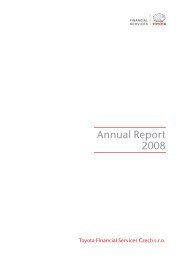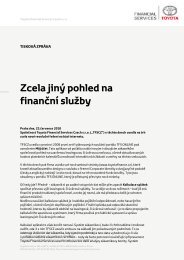Annual Report 2009 - Toyota Financial Services
Annual Report 2009 - Toyota Financial Services
Annual Report 2009 - Toyota Financial Services
Create successful ePaper yourself
Turn your PDF publications into a flip-book with our unique Google optimized e-Paper software.
<strong>Annual</strong> <strong>Report</strong> <strong>2009</strong>Risk ManagementCredit riskCredit risk is based mainly on the receivables from lease and loan contracts and is largely secured by the assets financed, whichare repossessed and sold in the event of default.In the process of reducing the above risk, the Company became as early as in 2006 a member of the Non-banking Registerof Client Information (NRKI) which serves to inform non-banking entities on the financial standing, credibility and paymentmorale of their clients. NRKI also provides for the exchange of the relevant data with the Banking Register of Client Information.The company also monitors the status of its current clients on a daily basis using tools provided by specialised externalcompanies.Credit risk is evaluated monthly on the basis of the monitoring of the amount of individual receivables and the relevantprovisions.The company recovers its receivables in relation to the reminder procedure which has three stages (e-mail, written andtelephone reminders). If the client fails to repay its liabilities even after these invitations to pay, the company withdraws fromthe contract, i.e. the contract is prematurely terminated and the client is invited to hand over the financed asset. If the client failsboth to repay his debt and to hand over the financed asset, the portfolio management employee hands over the supportingdocumentation along with the contract and the quantified amount of the debt to a contractual recovery agency which providesdebt recovery and eventually the confiscation of the asset financed. The proceeds from the sale of the repossessed assets shallcover the claims of the company, and any potential remaining debt is forwarded to a contractual law firm to be recovered bylegal means, often in execution proceedings.Liquidity riskLiquidity risk is the risk that the company is unable to meet its obligations due to lack of funds. Sufficient quantities of liquidfunds are ensured through cash flow management which eliminates unexpected demands on cash resources.To hedge against the liquidity risk, the company cooperates with banks with a high credit rating provided by internationalrating agencies, a higher number of cooperating banks, sets credit line limits (maximum drawdown of 75% of the total creditline), and works with the share of long-term loans (up to 50% of the total value of the loans drawn).Interest rate riskInterest rate risk consists in a change in market interest rates applied to refinancing resources. The objective of interest rate riskmanagement is to achieve stable interest costs by minimizing the impact of changes in the market interest rates. To ensure thisobjective, the company uses financial derivatives, interest rate swaps, by which it fixes the interest rates of its financial resources.21











